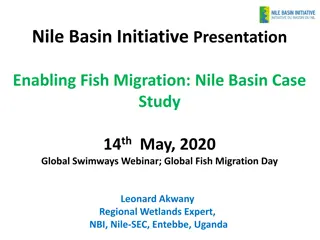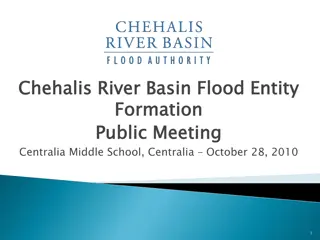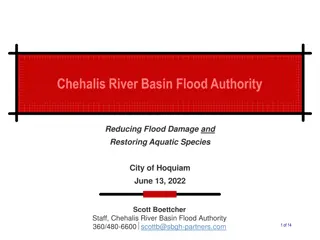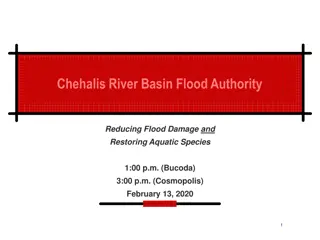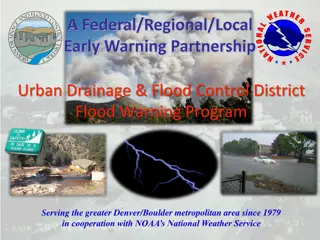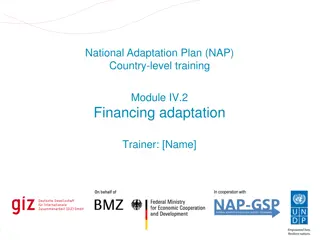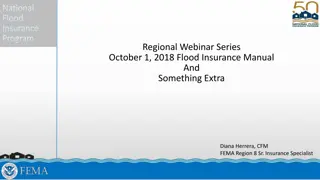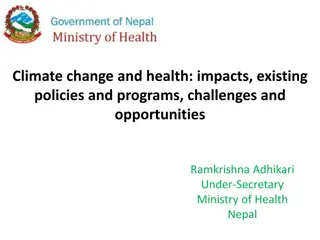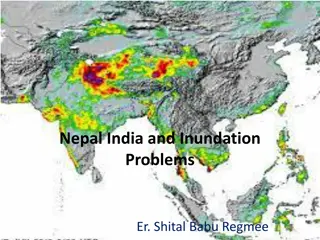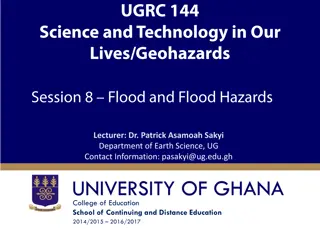Economic Analysis of Climate-Induced Flood Adaptation in Koshi Basin, Nepal
This project aims to assess the impact of climate-induced floods on agriculture in the Koshi basin of Terai, Nepal. By evaluating flood risk, economic costs, and different adaptation options, the study seeks to enhance resilience in the face of increasing flood occurrences catalyzed by climate change. Employing a mix of methodologies including GIS mapping, flood modeling, and economic analysis, the research delves into the implications on agriculture productivity, land utilization, and adaptation strategies like submergence-tolerant rice varieties and flood protection through riparian plantation.
Download Presentation

Please find below an Image/Link to download the presentation.
The content on the website is provided AS IS for your information and personal use only. It may not be sold, licensed, or shared on other websites without obtaining consent from the author. Download presentation by click this link. If you encounter any issues during the download, it is possible that the publisher has removed the file from their server.
E N D
Presentation Transcript
AN ECONOMIC ANALYSIS ADAPTATION TO CLIMATE INDUCED FLOODS IN KOSHI BASIN OF TERAI NEPAL
PROJECT BACKGROUND Climate vulnerable country, High dependence on environmental resources Erratic nature of the monsoon rainfall pattern and climate extreme events , increased mean annual precipitation; with decreased of rainy days with increased number of high-intensity rainfall events. Flood incidence increased in Nepalese context Floods in Koshi: Koshi river basin, which carries highest siltation among Nepali river, damaging million of hectare of arable land.
OBJECTIVES Objectives The overall objective is to assess climate induced flood risk and evaluate adaptations options suitable for agriculture resilience in Koshi basin of Terai Nepal. Specific Objectives To estimate physical impacts of climate induced flood risk in Koshi river basin area of Terai Nepal; To calculate economic cost of floods in agriculture production; To identify and compare economic cost and benefit of different adaptation options; and To rank different flood adaptation options based on obtained NPV.
METHODOLOGY Deductive and Inductive Approach, Use of Flood and Crop yield simulation Studies GIS based mapping for area decline with floods in different years Different Scenario Analysis With flood hazards without CC and increased floods hazards in CC context. Flood model/hydrological models Precipitation: Seasonal variability, inter-annual variation, Recurrence of floods and intensity and frequency Past extreme events, its increased intensity, frequency and recurrence in recent years. Satellite images captured in different in flood years
METHODOLOGY With flood hazards without CC and increased floods hazards in CC context. Flood model/hydrological models Precipitation: Seasonal variability, inter-annual variation, Recurrence of floods and intensity and frequency Past extreme events, its increased intensity, frequency and recurrence in recent years. Satellite images captured in different in flood years Losses in agriculture production with flood hazards and with increased flood hazards due climate change. Land loss Production decline, farming system, Agriculture productivity, production trend, Recardian model for impact on agriculture production(decline of net revenue)
METHODOLOGY Losses in agriculture production with flood hazards and with increased flood hazards due climate change. Land loss Production decline, farming system, Agriculture productivity, production trend, Recardian model for impact on agriculture production(decline of net revenue) Cost of and Benefit of Adaptation options. Cost of agriculture Adaptation; Submergence-tolerant rice varieties and river-belt farming (with floods) Flood protection: Riperian Plantation(without floods
DATA REQUIRED Type of Data Precipitation Collection method GCM, RCM and Downscaled data GIS images, mode,FGDs and KII Source of Data Collection DHM, DWIDC Floods, intensity, recurrence Agriculture Land loss extreme events, frequency, flood Observation/ Field Survey Crop loss Productivity method Cost of treatment Cost of treatment decline District Office(DADO) District Forest Office, Production cost obtained from DADO. Agriculture Development Cost of Riparian plantation Cost of CSA; Submergence rice varieties and river-belt farming Benefit of Adaptation with floods and without floods Productivity method Field Survey
Evaluation of adaptation cost and benefit of flood management Analysis Options Do Nothing Costs Losses of crop production fallow of land. Losses of household income. Benefits The forgone cost river bank plantation Or For gone cost of use of submergence rice varieties Or Forgone cost of river-belt farming Higher production Income and Introduction of submergence rice varieties and river belt farming Implementation of participatory river plantation Capital cost of crop varieties, input materials Capital cost of plants, land sloping, bamboo, Recreation value, high land value, better production and income.
THANK YOU Q&A






